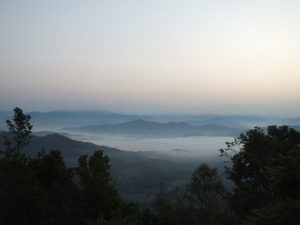
Roughing it in Nepal
This first week in Nepal has been a crash course of how to live in the developing world with three nights on a farm and four nights at village homestays! We’ve eaten fresh Nepali food, used bucket showers, and washed our clothes by hand. If that doesn’t scare you off (and it shouldn’t, it was quite the adventure) consider coming to Nepal next year!
Our first stop this week was up into the mountains to stay at a small permaculture farm. There we learned about the benefits of small scale permaculture farms and the positive impacts that come from integrating crop growth. Everything on the farm has a purpose and waste is always reused and recycled.
 At the farm everything we ate was grown right on the farm where we were staying. This was our first experience with Nepali food. It was fresh and delicious! In addition to the food, the view was amazing. On our last night it poured rain so in the morning we could see the Himalayan Mountains faintly in the background. It was a sight that I will never forget. The sunrise at the farm over the mountains was breathtaking!
At the farm everything we ate was grown right on the farm where we were staying. This was our first experience with Nepali food. It was fresh and delicious! In addition to the food, the view was amazing. On our last night it poured rain so in the morning we could see the Himalayan Mountains faintly in the background. It was a sight that I will never forget. The sunrise at the farm over the mountains was breathtaking!
After the farm we headed to homestays in a village called Almatari. This village sits in one of Nepal’s buffer zones. This is an area sitting between the wildlife conservation areas like Chitwan National Park and highly populated areas where people live. This is where wildlife and humans coexist.
Here we learned all about the sustainability initiatives of the village from growing food to biogas as a renewable energy source. We rode elephants and were immersed in the culture as we split into small groups and were adopted by a family for our stay.
Staying in the buffer zones made our team face complex sustainability questions. Nepal is a small country with a large population. It’s hard to create conservation areas because there isn’t much room to have a space dedicated to just wildlife. Where do you put the people? We brought up important questions about how to treat animals fairly while creating a sustainable space for humans to live. These were important questions that can’t be answered overnight! However, it was an exciting experience to get our feet wet and begin to learn about buffer zones and wildlife conservation.

